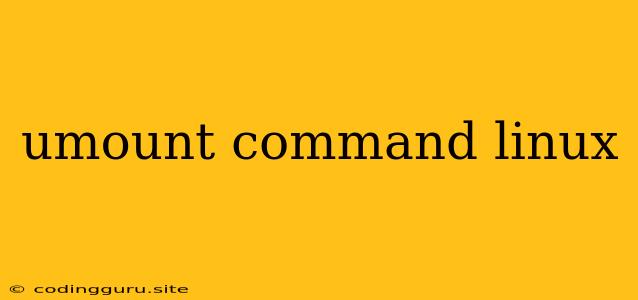Understanding the umount Command in Linux
The umount command is a fundamental tool in Linux for safely disconnecting mounted file systems. It ensures that data integrity is maintained while allowing you to safely remove external drives or partitions. But what exactly does umount do, and why is it so important?
What is umount and Why is It Essential?
Imagine you're working on a document on your computer, and suddenly you unplug the external hard drive where the document is saved. The result? Potential data loss and system instability. This is where umount comes in. It provides a controlled way to unlink a file system from its mount point, preventing any unexpected consequences.
Think of mounting a file system as attaching a new drive to your computer. umount is the act of safely detaching that drive, ensuring that all data is properly written and the connection is cleanly broken.
How Does umount Work?
When you use the umount command, it performs several crucial steps:
-
Checks for Active Processes:
umountchecks if any programs or processes are currently accessing the mounted file system. If any are found, it will refuse to unmount the file system until those processes are terminated or release their hold. -
Cleans Up Data: Before unmounting,
umountensures all data is written to disk. This prevents data loss that can occur if a file system is unmounted while data is still being written. -
Releases the Mount Point: After the checks and cleanup are completed,
umountreleases the mount point, making the file system inaccessible. This effectively detaches the file system from your Linux system.
Using the umount Command: A Practical Guide
Basic Usage:
umount /path/to/mount/point
Replace /path/to/mount/point with the actual path where the file system is mounted. For example:
umount /dev/sdb1
umount /mnt/mydrive
Unmounting Multiple File Systems:
You can unmount multiple file systems by providing their mount points separated by spaces:
umount /dev/sdb1 /mnt/mydrive
Unmounting with Force (Caution!):
In rare circumstances, you may need to force an unmount. However, use this option with extreme caution, as it can potentially lead to data loss if the file system is actively being used:
umount -f /path/to/mount/point
Unmounting Specific Filesystems:
The umount command can unmount specific file system types. For example, to unmount a NFS (Network File System) volume:
umount -t nfs /path/to/mount/point
Common Errors and Troubleshooting
Error 1: Device or Resource Busy:
This error indicates that a program or process is still using the mounted file system. Identify the process using ps aux | grep /path/to/mount/point and terminate it.
Error 2: No Such File or Directory:
This error means the specified mount point doesn't exist. Double-check the path and make sure it's correct.
Error 3: Operation Not Permitted:
This error usually occurs if you lack the necessary permissions to unmount the file system. You may need to use sudo to elevate your privileges.
Best Practices for Safe and Efficient Unmounting
- Always Unmount Before Physical Disconnection: Never unplug an external drive or eject a CD/DVD without unmounting it first.
- Use
umountBeforefdiskormkfs: Before using commands likefdiskormkfsto partition or format a drive, ensure the drive is unmounted. - Prioritize Safety Over Speed: Avoid using the
-fflag for forced unmounts unless absolutely necessary, as it could lead to data loss.
Conclusion
The umount command plays a crucial role in ensuring the safety and stability of your Linux system. Understanding its functionality, how to use it correctly, and the common errors that can occur empowers you to manage your file systems effectively and prevent potential data loss. By following best practices and using umount responsibly, you can ensure the integrity of your data and the smooth operation of your Linux system.
